Corporate Innovation and Entrepreneurship: MBA Innovativeness Report
VerifiedAdded on 2023/06/07
|21
|5744
|169
Report
AI Summary
This report provides a comprehensive analysis of the climate for creativity and innovation within MBA, addressing key aspects such as creating an innovative platform and fostering an organizational climate that promotes creativity. It delves into the qualities and skills of creative leadership, examining its performance in volatile times, and explores open innovation strategies, including ambidexterity in a VUCA world. The report considers the context of MBA Matchbox Architects and the challenges they face, such as miscommunication and leadership issues, and recommends interventions at multiple organizational levels to enhance innovation. Recommendations include attracting and retaining quality leaders, implementing performance evaluations, and utilizing simulation and e-mentoring tools to develop leadership capacity. The report also highlights the importance of organizational learning, two-way communication, and the adoption of game-based technologies to enhance the organizational climate for creativity and innovation.
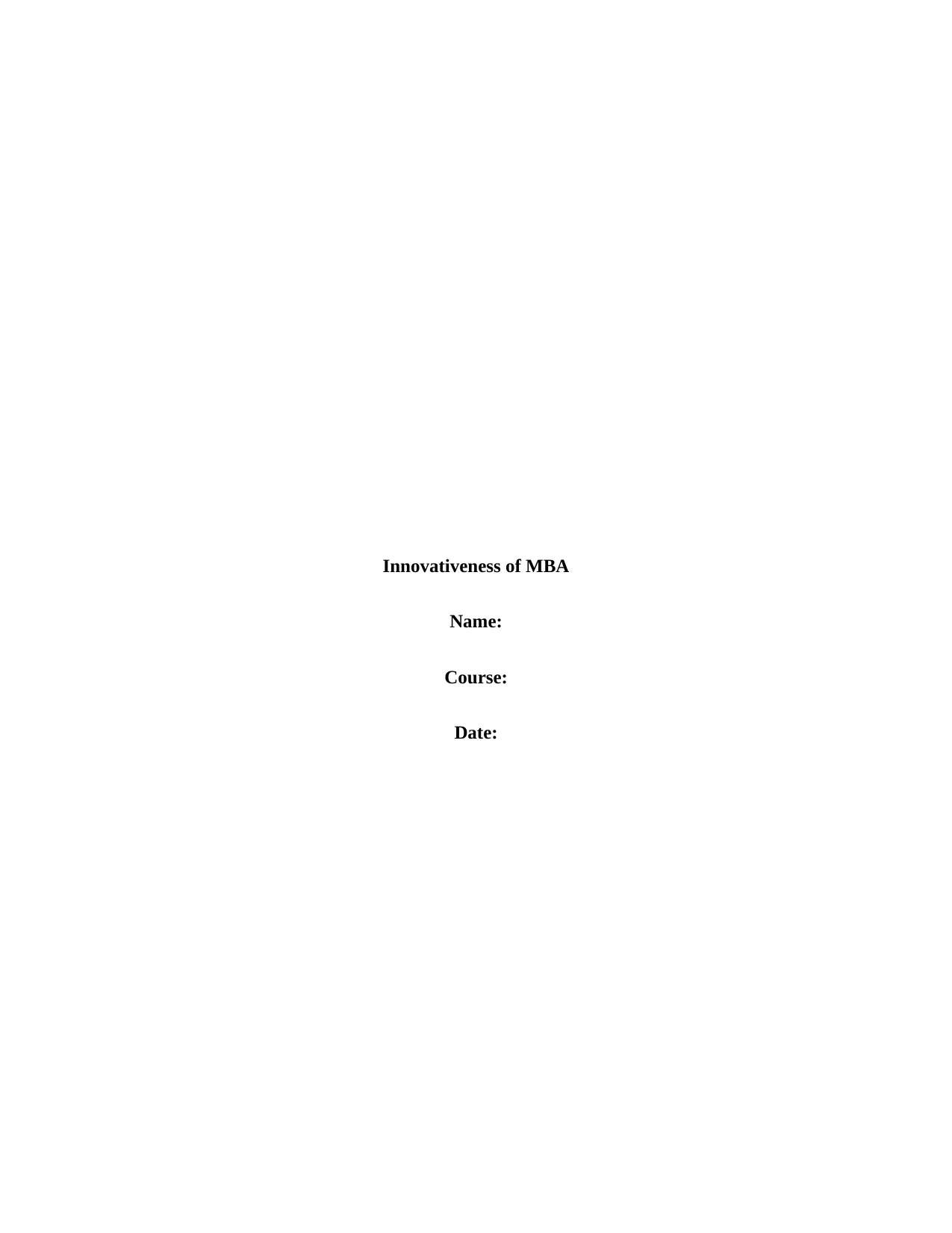
Innovativeness of MBA
Name:
Course:
Date:
Name:
Course:
Date:
Paraphrase This Document
Need a fresh take? Get an instant paraphrase of this document with our AI Paraphraser
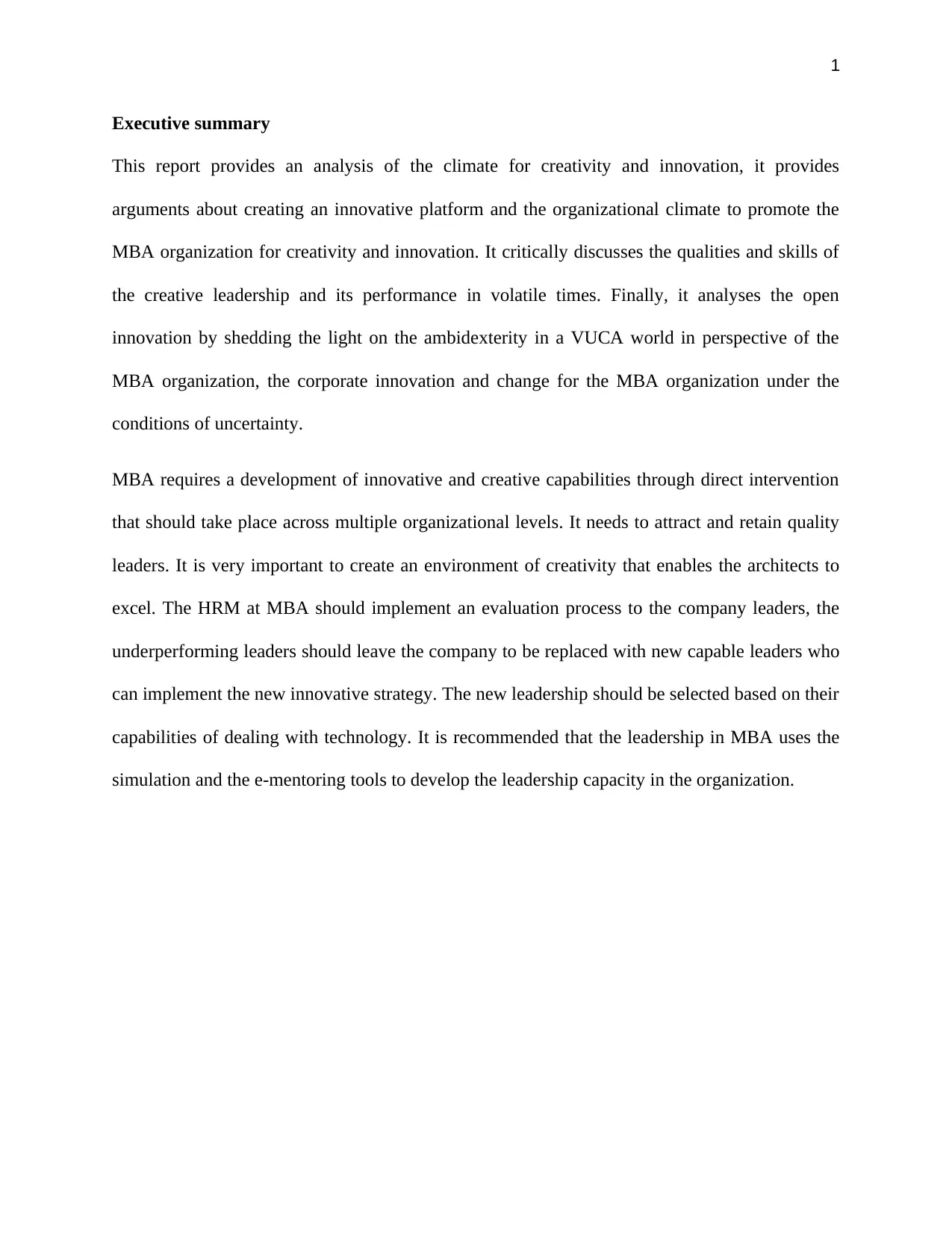
1
Executive summary
This report provides an analysis of the climate for creativity and innovation, it provides
arguments about creating an innovative platform and the organizational climate to promote the
MBA organization for creativity and innovation. It critically discusses the qualities and skills of
the creative leadership and its performance in volatile times. Finally, it analyses the open
innovation by shedding the light on the ambidexterity in a VUCA world in perspective of the
MBA organization, the corporate innovation and change for the MBA organization under the
conditions of uncertainty.
MBA requires a development of innovative and creative capabilities through direct intervention
that should take place across multiple organizational levels. It needs to attract and retain quality
leaders. It is very important to create an environment of creativity that enables the architects to
excel. The HRM at MBA should implement an evaluation process to the company leaders, the
underperforming leaders should leave the company to be replaced with new capable leaders who
can implement the new innovative strategy. The new leadership should be selected based on their
capabilities of dealing with technology. It is recommended that the leadership in MBA uses the
simulation and the e-mentoring tools to develop the leadership capacity in the organization.
Executive summary
This report provides an analysis of the climate for creativity and innovation, it provides
arguments about creating an innovative platform and the organizational climate to promote the
MBA organization for creativity and innovation. It critically discusses the qualities and skills of
the creative leadership and its performance in volatile times. Finally, it analyses the open
innovation by shedding the light on the ambidexterity in a VUCA world in perspective of the
MBA organization, the corporate innovation and change for the MBA organization under the
conditions of uncertainty.
MBA requires a development of innovative and creative capabilities through direct intervention
that should take place across multiple organizational levels. It needs to attract and retain quality
leaders. It is very important to create an environment of creativity that enables the architects to
excel. The HRM at MBA should implement an evaluation process to the company leaders, the
underperforming leaders should leave the company to be replaced with new capable leaders who
can implement the new innovative strategy. The new leadership should be selected based on their
capabilities of dealing with technology. It is recommended that the leadership in MBA uses the
simulation and the e-mentoring tools to develop the leadership capacity in the organization.
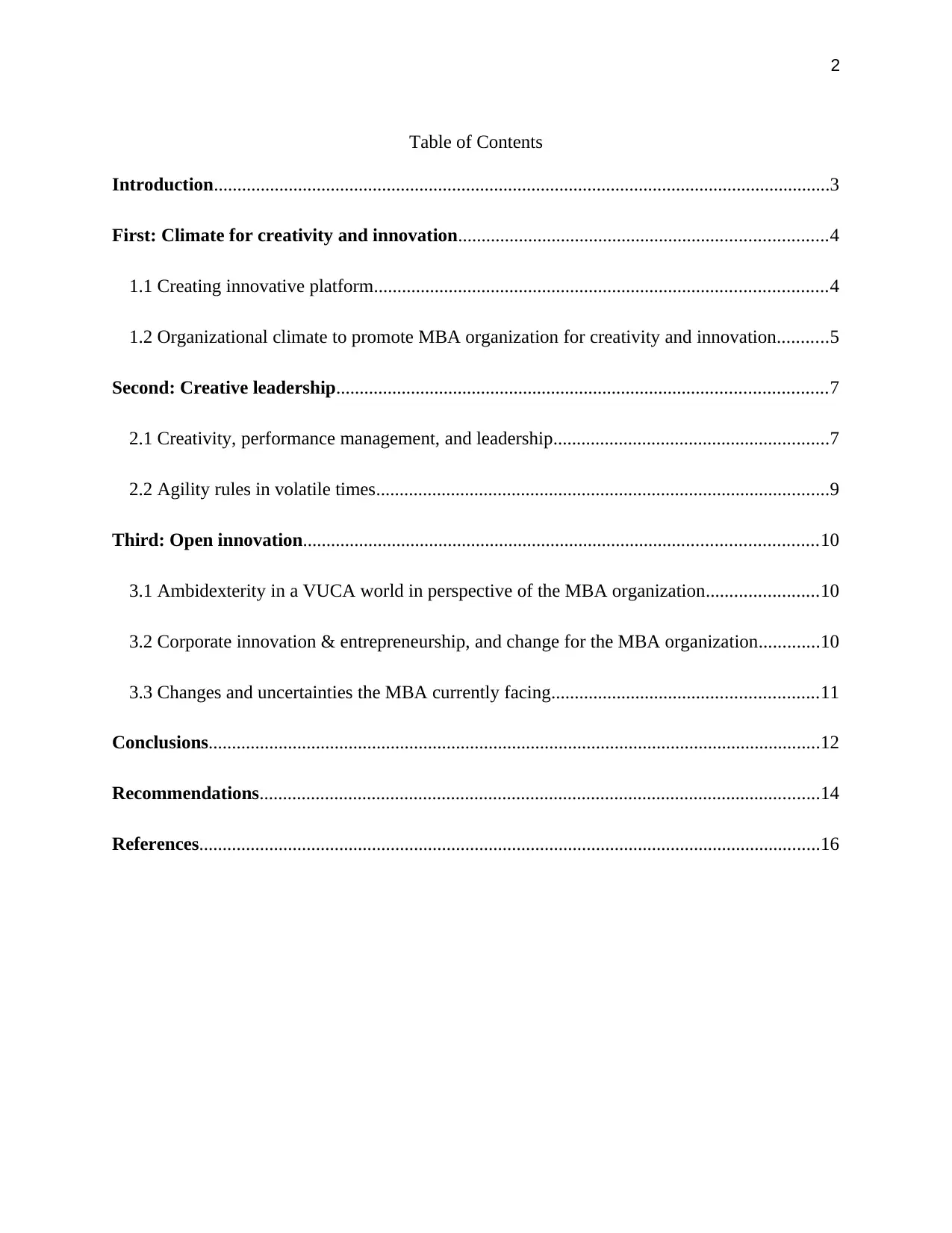
2
Table of Contents
Introduction....................................................................................................................................3
First: Climate for creativity and innovation...............................................................................4
1.1 Creating innovative platform.................................................................................................4
1.2 Organizational climate to promote MBA organization for creativity and innovation...........5
Second: Creative leadership.........................................................................................................7
2.1 Creativity, performance management, and leadership...........................................................7
2.2 Agility rules in volatile times.................................................................................................9
Third: Open innovation..............................................................................................................10
3.1 Ambidexterity in a VUCA world in perspective of the MBA organization........................10
3.2 Corporate innovation & entrepreneurship, and change for the MBA organization.............10
3.3 Changes and uncertainties the MBA currently facing.........................................................11
Conclusions...................................................................................................................................12
Recommendations........................................................................................................................14
References.....................................................................................................................................16
Table of Contents
Introduction....................................................................................................................................3
First: Climate for creativity and innovation...............................................................................4
1.1 Creating innovative platform.................................................................................................4
1.2 Organizational climate to promote MBA organization for creativity and innovation...........5
Second: Creative leadership.........................................................................................................7
2.1 Creativity, performance management, and leadership...........................................................7
2.2 Agility rules in volatile times.................................................................................................9
Third: Open innovation..............................................................................................................10
3.1 Ambidexterity in a VUCA world in perspective of the MBA organization........................10
3.2 Corporate innovation & entrepreneurship, and change for the MBA organization.............10
3.3 Changes and uncertainties the MBA currently facing.........................................................11
Conclusions...................................................................................................................................12
Recommendations........................................................................................................................14
References.....................................................................................................................................16
⊘ This is a preview!⊘
Do you want full access?
Subscribe today to unlock all pages.

Trusted by 1+ million students worldwide
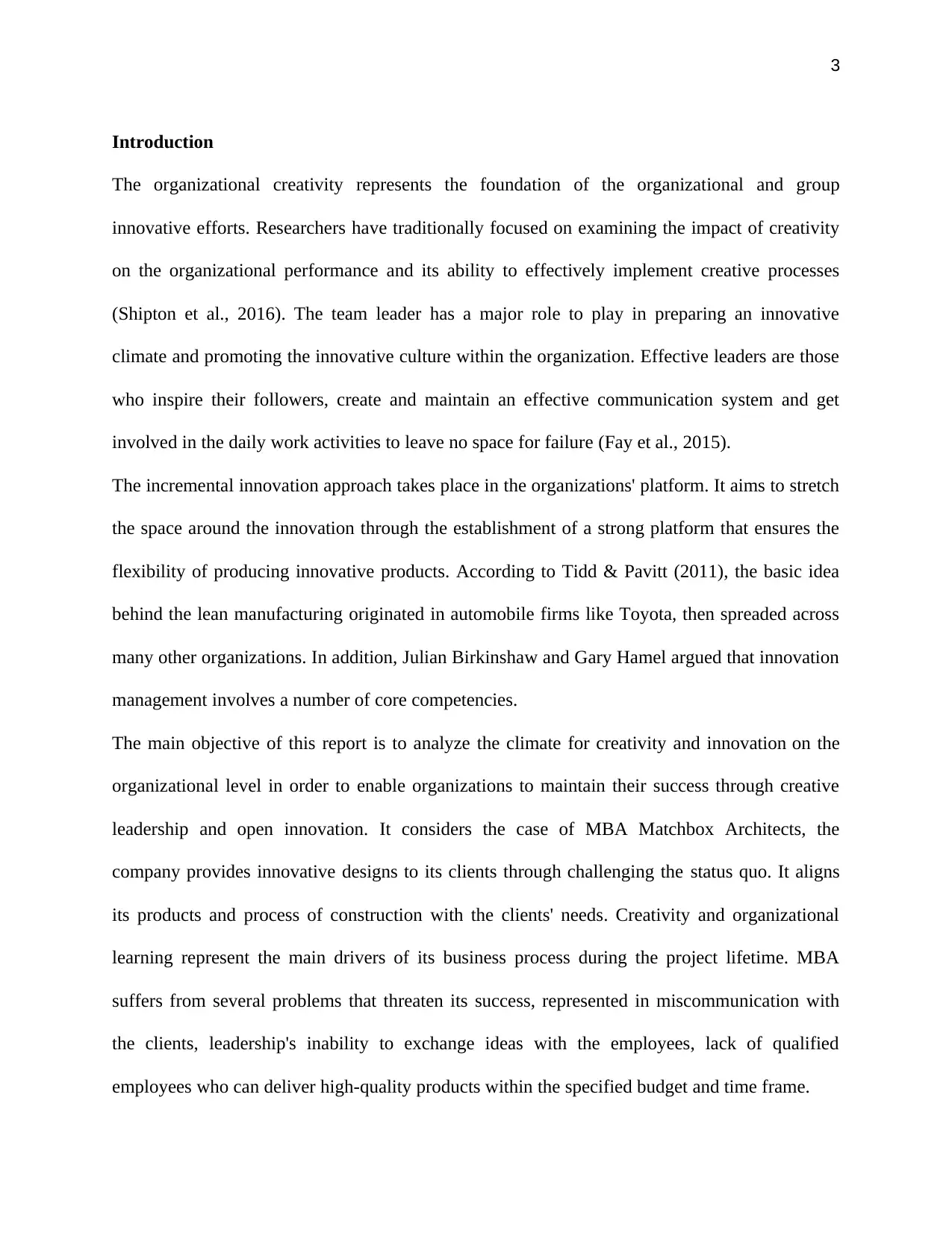
3
Introduction
The organizational creativity represents the foundation of the organizational and group
innovative efforts. Researchers have traditionally focused on examining the impact of creativity
on the organizational performance and its ability to effectively implement creative processes
(Shipton et al., 2016). The team leader has a major role to play in preparing an innovative
climate and promoting the innovative culture within the organization. Effective leaders are those
who inspire their followers, create and maintain an effective communication system and get
involved in the daily work activities to leave no space for failure (Fay et al., 2015).
The incremental innovation approach takes place in the organizations' platform. It aims to stretch
the space around the innovation through the establishment of a strong platform that ensures the
flexibility of producing innovative products. According to Tidd & Pavitt (2011), the basic idea
behind the lean manufacturing originated in automobile firms like Toyota, then spreaded across
many other organizations. In addition, Julian Birkinshaw and Gary Hamel argued that innovation
management involves a number of core competencies.
The main objective of this report is to analyze the climate for creativity and innovation on the
organizational level in order to enable organizations to maintain their success through creative
leadership and open innovation. It considers the case of MBA Matchbox Architects, the
company provides innovative designs to its clients through challenging the status quo. It aligns
its products and process of construction with the clients' needs. Creativity and organizational
learning represent the main drivers of its business process during the project lifetime. MBA
suffers from several problems that threaten its success, represented in miscommunication with
the clients, leadership's inability to exchange ideas with the employees, lack of qualified
employees who can deliver high-quality products within the specified budget and time frame.
Introduction
The organizational creativity represents the foundation of the organizational and group
innovative efforts. Researchers have traditionally focused on examining the impact of creativity
on the organizational performance and its ability to effectively implement creative processes
(Shipton et al., 2016). The team leader has a major role to play in preparing an innovative
climate and promoting the innovative culture within the organization. Effective leaders are those
who inspire their followers, create and maintain an effective communication system and get
involved in the daily work activities to leave no space for failure (Fay et al., 2015).
The incremental innovation approach takes place in the organizations' platform. It aims to stretch
the space around the innovation through the establishment of a strong platform that ensures the
flexibility of producing innovative products. According to Tidd & Pavitt (2011), the basic idea
behind the lean manufacturing originated in automobile firms like Toyota, then spreaded across
many other organizations. In addition, Julian Birkinshaw and Gary Hamel argued that innovation
management involves a number of core competencies.
The main objective of this report is to analyze the climate for creativity and innovation on the
organizational level in order to enable organizations to maintain their success through creative
leadership and open innovation. It considers the case of MBA Matchbox Architects, the
company provides innovative designs to its clients through challenging the status quo. It aligns
its products and process of construction with the clients' needs. Creativity and organizational
learning represent the main drivers of its business process during the project lifetime. MBA
suffers from several problems that threaten its success, represented in miscommunication with
the clients, leadership's inability to exchange ideas with the employees, lack of qualified
employees who can deliver high-quality products within the specified budget and time frame.
Paraphrase This Document
Need a fresh take? Get an instant paraphrase of this document with our AI Paraphraser
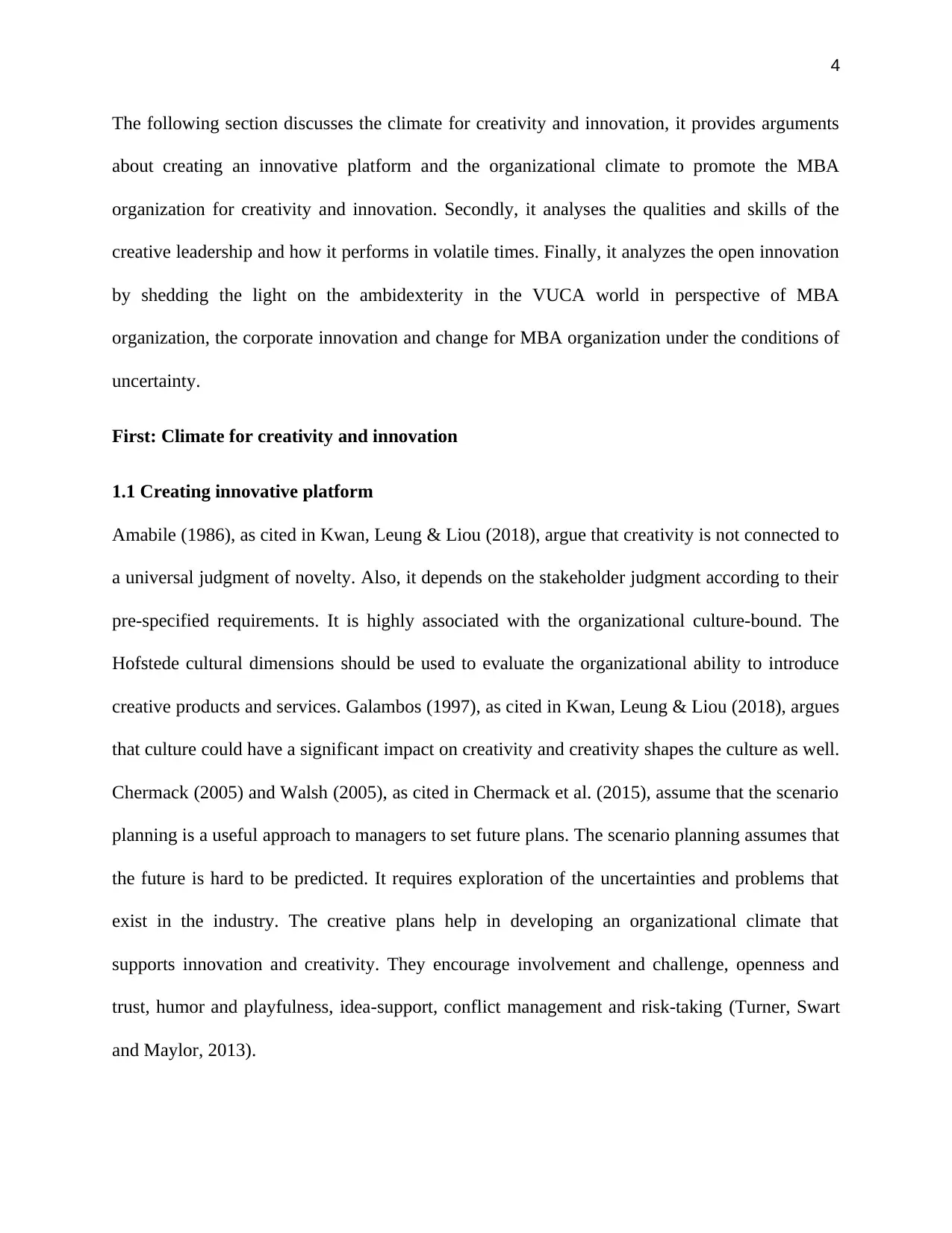
4
The following section discusses the climate for creativity and innovation, it provides arguments
about creating an innovative platform and the organizational climate to promote the MBA
organization for creativity and innovation. Secondly, it analyses the qualities and skills of the
creative leadership and how it performs in volatile times. Finally, it analyzes the open innovation
by shedding the light on the ambidexterity in the VUCA world in perspective of MBA
organization, the corporate innovation and change for MBA organization under the conditions of
uncertainty.
First: Climate for creativity and innovation
1.1 Creating innovative platform
Amabile (1986), as cited in Kwan, Leung & Liou (2018), argue that creativity is not connected to
a universal judgment of novelty. Also, it depends on the stakeholder judgment according to their
pre-specified requirements. It is highly associated with the organizational culture-bound. The
Hofstede cultural dimensions should be used to evaluate the organizational ability to introduce
creative products and services. Galambos (1997), as cited in Kwan, Leung & Liou (2018), argues
that culture could have a significant impact on creativity and creativity shapes the culture as well.
Chermack (2005) and Walsh (2005), as cited in Chermack et al. (2015), assume that the scenario
planning is a useful approach to managers to set future plans. The scenario planning assumes that
the future is hard to be predicted. It requires exploration of the uncertainties and problems that
exist in the industry. The creative plans help in developing an organizational climate that
supports innovation and creativity. They encourage involvement and challenge, openness and
trust, humor and playfulness, idea-support, conflict management and risk-taking (Turner, Swart
and Maylor, 2013).
The following section discusses the climate for creativity and innovation, it provides arguments
about creating an innovative platform and the organizational climate to promote the MBA
organization for creativity and innovation. Secondly, it analyses the qualities and skills of the
creative leadership and how it performs in volatile times. Finally, it analyzes the open innovation
by shedding the light on the ambidexterity in the VUCA world in perspective of MBA
organization, the corporate innovation and change for MBA organization under the conditions of
uncertainty.
First: Climate for creativity and innovation
1.1 Creating innovative platform
Amabile (1986), as cited in Kwan, Leung & Liou (2018), argue that creativity is not connected to
a universal judgment of novelty. Also, it depends on the stakeholder judgment according to their
pre-specified requirements. It is highly associated with the organizational culture-bound. The
Hofstede cultural dimensions should be used to evaluate the organizational ability to introduce
creative products and services. Galambos (1997), as cited in Kwan, Leung & Liou (2018), argues
that culture could have a significant impact on creativity and creativity shapes the culture as well.
Chermack (2005) and Walsh (2005), as cited in Chermack et al. (2015), assume that the scenario
planning is a useful approach to managers to set future plans. The scenario planning assumes that
the future is hard to be predicted. It requires exploration of the uncertainties and problems that
exist in the industry. The creative plans help in developing an organizational climate that
supports innovation and creativity. They encourage involvement and challenge, openness and
trust, humor and playfulness, idea-support, conflict management and risk-taking (Turner, Swart
and Maylor, 2013).
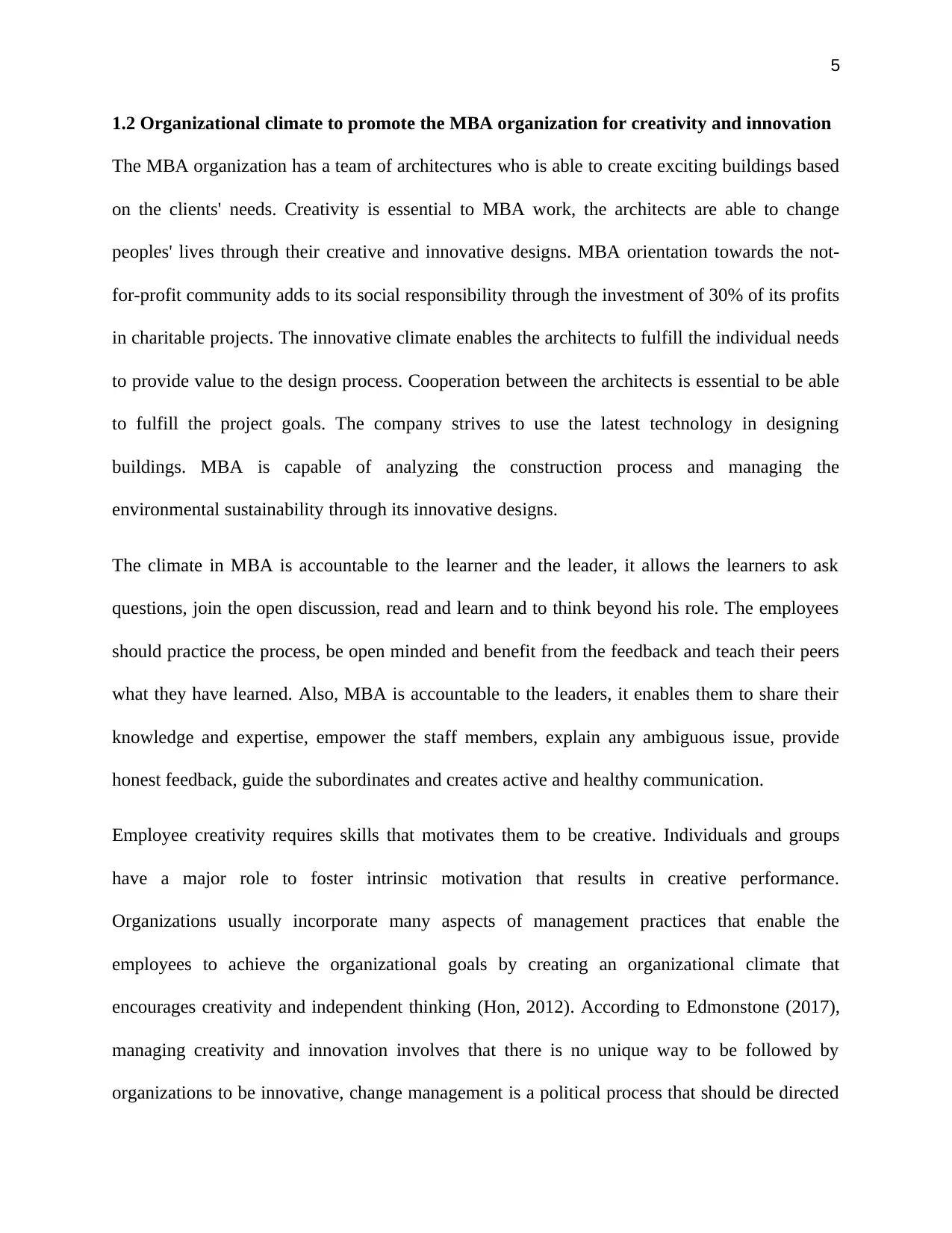
5
1.2 Organizational climate to promote the MBA organization for creativity and innovation
The MBA organization has a team of architectures who is able to create exciting buildings based
on the clients' needs. Creativity is essential to MBA work, the architects are able to change
peoples' lives through their creative and innovative designs. MBA orientation towards the not-
for-profit community adds to its social responsibility through the investment of 30% of its profits
in charitable projects. The innovative climate enables the architects to fulfill the individual needs
to provide value to the design process. Cooperation between the architects is essential to be able
to fulfill the project goals. The company strives to use the latest technology in designing
buildings. MBA is capable of analyzing the construction process and managing the
environmental sustainability through its innovative designs.
The climate in MBA is accountable to the learner and the leader, it allows the learners to ask
questions, join the open discussion, read and learn and to think beyond his role. The employees
should practice the process, be open minded and benefit from the feedback and teach their peers
what they have learned. Also, MBA is accountable to the leaders, it enables them to share their
knowledge and expertise, empower the staff members, explain any ambiguous issue, provide
honest feedback, guide the subordinates and creates active and healthy communication.
Employee creativity requires skills that motivates them to be creative. Individuals and groups
have a major role to foster intrinsic motivation that results in creative performance.
Organizations usually incorporate many aspects of management practices that enable the
employees to achieve the organizational goals by creating an organizational climate that
encourages creativity and independent thinking (Hon, 2012). According to Edmonstone (2017),
managing creativity and innovation involves that there is no unique way to be followed by
organizations to be innovative, change management is a political process that should be directed
1.2 Organizational climate to promote the MBA organization for creativity and innovation
The MBA organization has a team of architectures who is able to create exciting buildings based
on the clients' needs. Creativity is essential to MBA work, the architects are able to change
peoples' lives through their creative and innovative designs. MBA orientation towards the not-
for-profit community adds to its social responsibility through the investment of 30% of its profits
in charitable projects. The innovative climate enables the architects to fulfill the individual needs
to provide value to the design process. Cooperation between the architects is essential to be able
to fulfill the project goals. The company strives to use the latest technology in designing
buildings. MBA is capable of analyzing the construction process and managing the
environmental sustainability through its innovative designs.
The climate in MBA is accountable to the learner and the leader, it allows the learners to ask
questions, join the open discussion, read and learn and to think beyond his role. The employees
should practice the process, be open minded and benefit from the feedback and teach their peers
what they have learned. Also, MBA is accountable to the leaders, it enables them to share their
knowledge and expertise, empower the staff members, explain any ambiguous issue, provide
honest feedback, guide the subordinates and creates active and healthy communication.
Employee creativity requires skills that motivates them to be creative. Individuals and groups
have a major role to foster intrinsic motivation that results in creative performance.
Organizations usually incorporate many aspects of management practices that enable the
employees to achieve the organizational goals by creating an organizational climate that
encourages creativity and independent thinking (Hon, 2012). According to Edmonstone (2017),
managing creativity and innovation involves that there is no unique way to be followed by
organizations to be innovative, change management is a political process that should be directed
⊘ This is a preview!⊘
Do you want full access?
Subscribe today to unlock all pages.

Trusted by 1+ million students worldwide
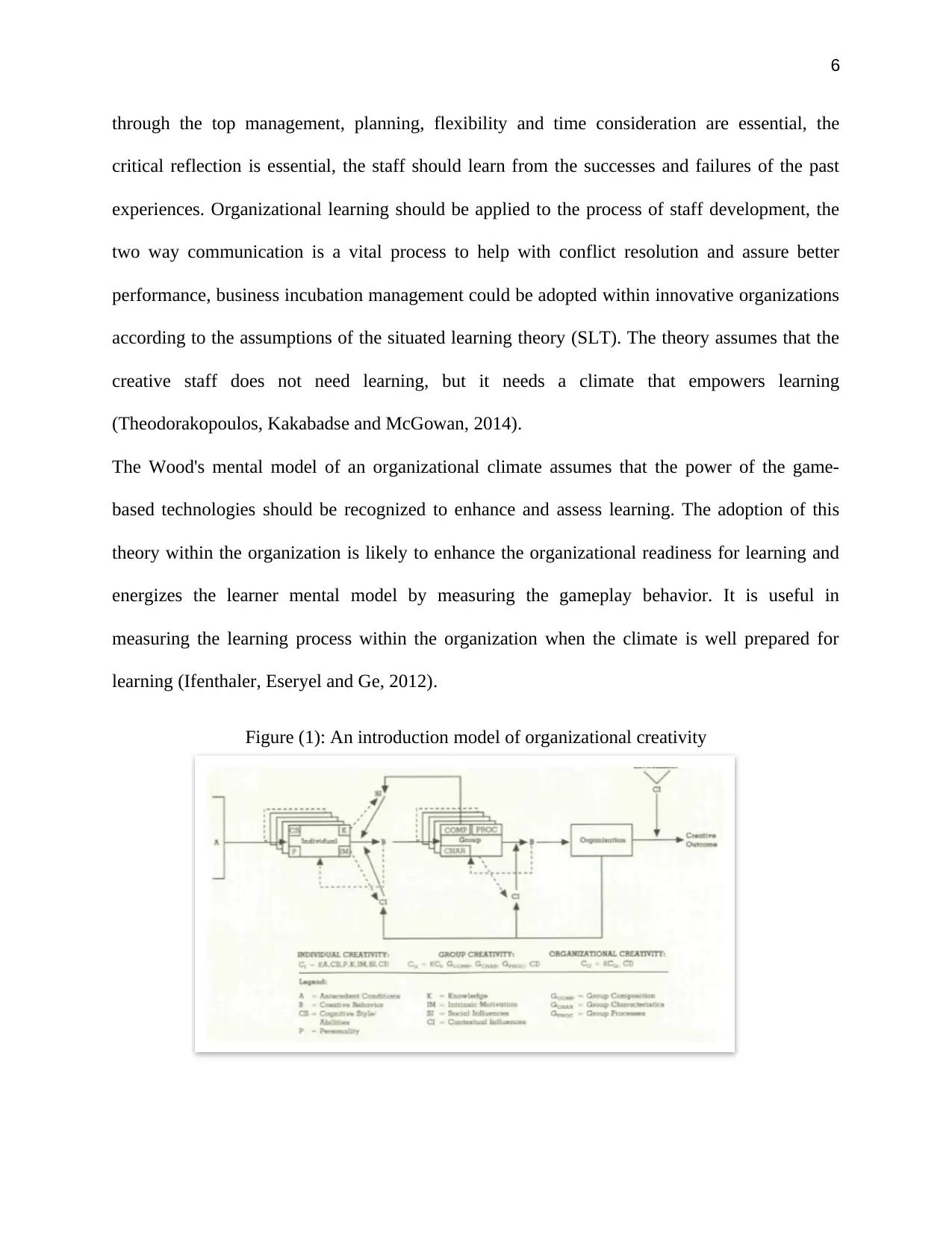
6
through the top management, planning, flexibility and time consideration are essential, the
critical reflection is essential, the staff should learn from the successes and failures of the past
experiences. Organizational learning should be applied to the process of staff development, the
two way communication is a vital process to help with conflict resolution and assure better
performance, business incubation management could be adopted within innovative organizations
according to the assumptions of the situated learning theory (SLT). The theory assumes that the
creative staff does not need learning, but it needs a climate that empowers learning
(Theodorakopoulos, Kakabadse and McGowan, 2014).
The Wood's mental model of an organizational climate assumes that the power of the game-
based technologies should be recognized to enhance and assess learning. The adoption of this
theory within the organization is likely to enhance the organizational readiness for learning and
energizes the learner mental model by measuring the gameplay behavior. It is useful in
measuring the learning process within the organization when the climate is well prepared for
learning (Ifenthaler, Eseryel and Ge, 2012).
Figure (1): An introduction model of organizational creativity
through the top management, planning, flexibility and time consideration are essential, the
critical reflection is essential, the staff should learn from the successes and failures of the past
experiences. Organizational learning should be applied to the process of staff development, the
two way communication is a vital process to help with conflict resolution and assure better
performance, business incubation management could be adopted within innovative organizations
according to the assumptions of the situated learning theory (SLT). The theory assumes that the
creative staff does not need learning, but it needs a climate that empowers learning
(Theodorakopoulos, Kakabadse and McGowan, 2014).
The Wood's mental model of an organizational climate assumes that the power of the game-
based technologies should be recognized to enhance and assess learning. The adoption of this
theory within the organization is likely to enhance the organizational readiness for learning and
energizes the learner mental model by measuring the gameplay behavior. It is useful in
measuring the learning process within the organization when the climate is well prepared for
learning (Ifenthaler, Eseryel and Ge, 2012).
Figure (1): An introduction model of organizational creativity
Paraphrase This Document
Need a fresh take? Get an instant paraphrase of this document with our AI Paraphraser
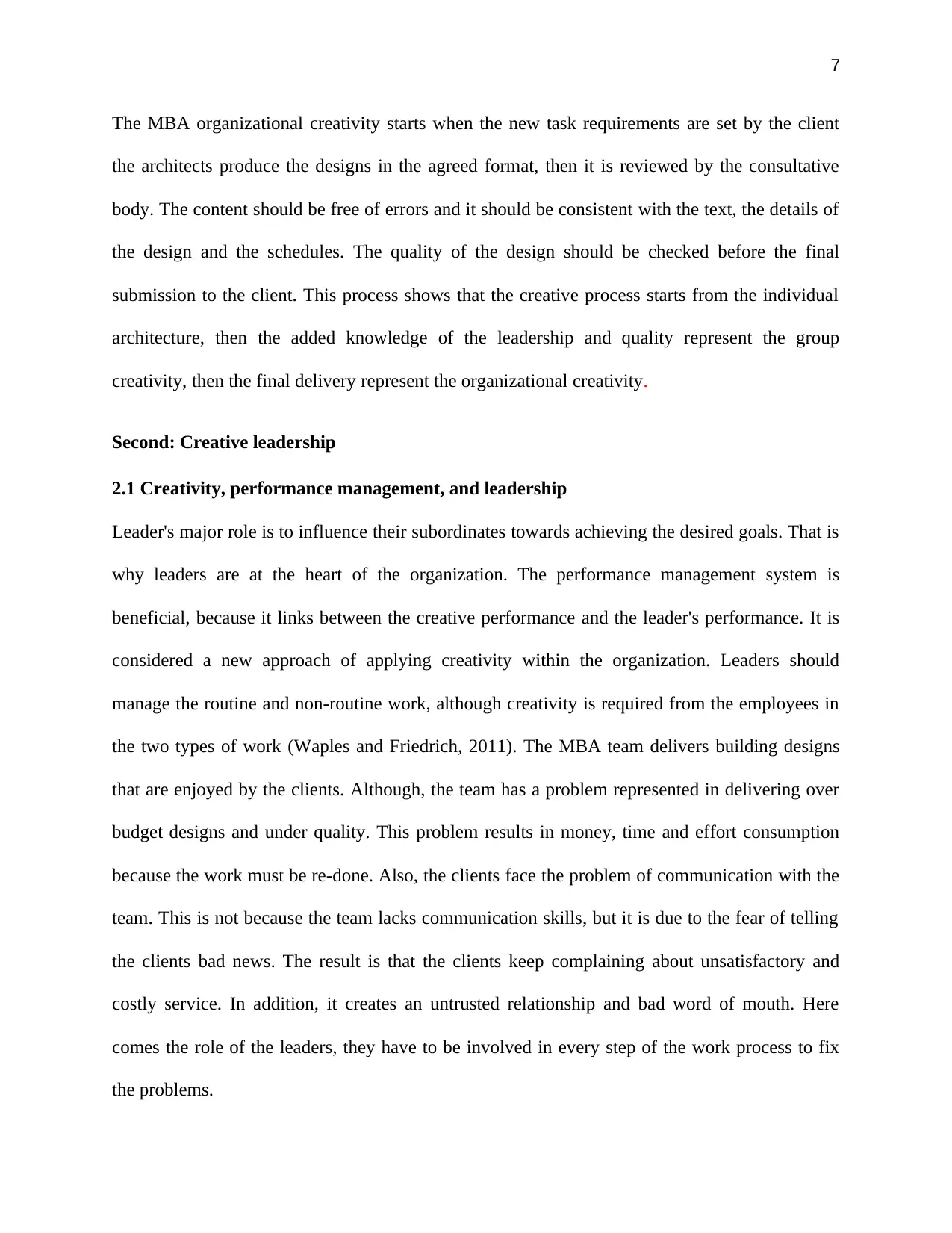
7
The MBA organizational creativity starts when the new task requirements are set by the client
the architects produce the designs in the agreed format, then it is reviewed by the consultative
body. The content should be free of errors and it should be consistent with the text, the details of
the design and the schedules. The quality of the design should be checked before the final
submission to the client. This process shows that the creative process starts from the individual
architecture, then the added knowledge of the leadership and quality represent the group
creativity, then the final delivery represent the organizational creativity.
Second: Creative leadership
2.1 Creativity, performance management, and leadership
Leader's major role is to influence their subordinates towards achieving the desired goals. That is
why leaders are at the heart of the organization. The performance management system is
beneficial, because it links between the creative performance and the leader's performance. It is
considered a new approach of applying creativity within the organization. Leaders should
manage the routine and non-routine work, although creativity is required from the employees in
the two types of work (Waples and Friedrich, 2011). The MBA team delivers building designs
that are enjoyed by the clients. Although, the team has a problem represented in delivering over
budget designs and under quality. This problem results in money, time and effort consumption
because the work must be re-done. Also, the clients face the problem of communication with the
team. This is not because the team lacks communication skills, but it is due to the fear of telling
the clients bad news. The result is that the clients keep complaining about unsatisfactory and
costly service. In addition, it creates an untrusted relationship and bad word of mouth. Here
comes the role of the leaders, they have to be involved in every step of the work process to fix
the problems.
The MBA organizational creativity starts when the new task requirements are set by the client
the architects produce the designs in the agreed format, then it is reviewed by the consultative
body. The content should be free of errors and it should be consistent with the text, the details of
the design and the schedules. The quality of the design should be checked before the final
submission to the client. This process shows that the creative process starts from the individual
architecture, then the added knowledge of the leadership and quality represent the group
creativity, then the final delivery represent the organizational creativity.
Second: Creative leadership
2.1 Creativity, performance management, and leadership
Leader's major role is to influence their subordinates towards achieving the desired goals. That is
why leaders are at the heart of the organization. The performance management system is
beneficial, because it links between the creative performance and the leader's performance. It is
considered a new approach of applying creativity within the organization. Leaders should
manage the routine and non-routine work, although creativity is required from the employees in
the two types of work (Waples and Friedrich, 2011). The MBA team delivers building designs
that are enjoyed by the clients. Although, the team has a problem represented in delivering over
budget designs and under quality. This problem results in money, time and effort consumption
because the work must be re-done. Also, the clients face the problem of communication with the
team. This is not because the team lacks communication skills, but it is due to the fear of telling
the clients bad news. The result is that the clients keep complaining about unsatisfactory and
costly service. In addition, it creates an untrusted relationship and bad word of mouth. Here
comes the role of the leaders, they have to be involved in every step of the work process to fix
the problems.
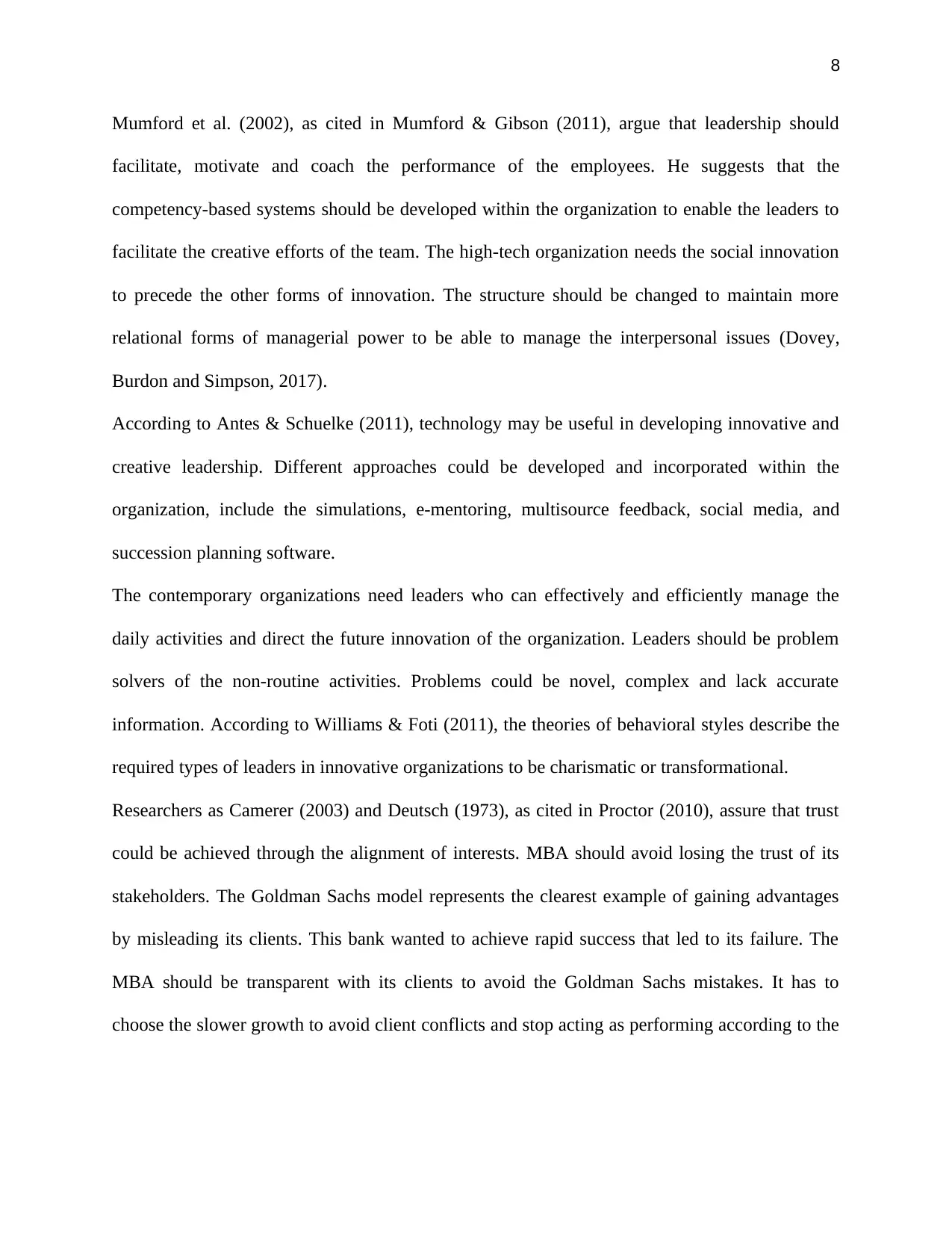
8
Mumford et al. (2002), as cited in Mumford & Gibson (2011), argue that leadership should
facilitate, motivate and coach the performance of the employees. He suggests that the
competency-based systems should be developed within the organization to enable the leaders to
facilitate the creative efforts of the team. The high-tech organization needs the social innovation
to precede the other forms of innovation. The structure should be changed to maintain more
relational forms of managerial power to be able to manage the interpersonal issues (Dovey,
Burdon and Simpson, 2017).
According to Antes & Schuelke (2011), technology may be useful in developing innovative and
creative leadership. Different approaches could be developed and incorporated within the
organization, include the simulations, e-mentoring, multisource feedback, social media, and
succession planning software.
The contemporary organizations need leaders who can effectively and efficiently manage the
daily activities and direct the future innovation of the organization. Leaders should be problem
solvers of the non-routine activities. Problems could be novel, complex and lack accurate
information. According to Williams & Foti (2011), the theories of behavioral styles describe the
required types of leaders in innovative organizations to be charismatic or transformational.
Researchers as Camerer (2003) and Deutsch (1973), as cited in Proctor (2010), assure that trust
could be achieved through the alignment of interests. MBA should avoid losing the trust of its
stakeholders. The Goldman Sachs model represents the clearest example of gaining advantages
by misleading its clients. This bank wanted to achieve rapid success that led to its failure. The
MBA should be transparent with its clients to avoid the Goldman Sachs mistakes. It has to
choose the slower growth to avoid client conflicts and stop acting as performing according to the
Mumford et al. (2002), as cited in Mumford & Gibson (2011), argue that leadership should
facilitate, motivate and coach the performance of the employees. He suggests that the
competency-based systems should be developed within the organization to enable the leaders to
facilitate the creative efforts of the team. The high-tech organization needs the social innovation
to precede the other forms of innovation. The structure should be changed to maintain more
relational forms of managerial power to be able to manage the interpersonal issues (Dovey,
Burdon and Simpson, 2017).
According to Antes & Schuelke (2011), technology may be useful in developing innovative and
creative leadership. Different approaches could be developed and incorporated within the
organization, include the simulations, e-mentoring, multisource feedback, social media, and
succession planning software.
The contemporary organizations need leaders who can effectively and efficiently manage the
daily activities and direct the future innovation of the organization. Leaders should be problem
solvers of the non-routine activities. Problems could be novel, complex and lack accurate
information. According to Williams & Foti (2011), the theories of behavioral styles describe the
required types of leaders in innovative organizations to be charismatic or transformational.
Researchers as Camerer (2003) and Deutsch (1973), as cited in Proctor (2010), assure that trust
could be achieved through the alignment of interests. MBA should avoid losing the trust of its
stakeholders. The Goldman Sachs model represents the clearest example of gaining advantages
by misleading its clients. This bank wanted to achieve rapid success that led to its failure. The
MBA should be transparent with its clients to avoid the Goldman Sachs mistakes. It has to
choose the slower growth to avoid client conflicts and stop acting as performing according to the
⊘ This is a preview!⊘
Do you want full access?
Subscribe today to unlock all pages.

Trusted by 1+ million students worldwide
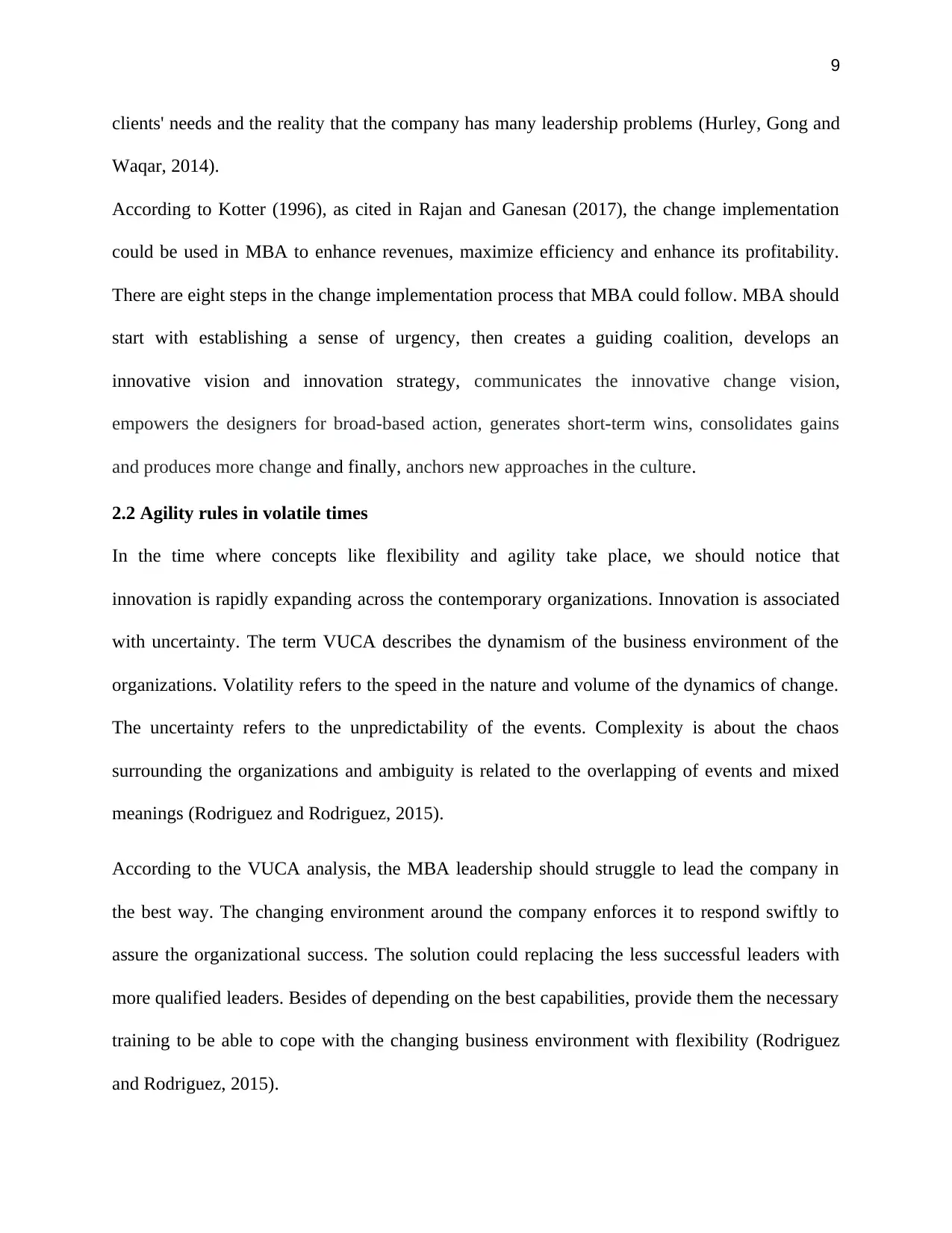
9
clients' needs and the reality that the company has many leadership problems (Hurley, Gong and
Waqar, 2014).
According to Kotter (1996), as cited in Rajan and Ganesan (2017), the change implementation
could be used in MBA to enhance revenues, maximize efficiency and enhance its profitability.
There are eight steps in the change implementation process that MBA could follow. MBA should
start with establishing a sense of urgency, then creates a guiding coalition, develops an
innovative vision and innovation strategy, communicates the innovative change vision,
empowers the designers for broad-based action, generates short-term wins, consolidates gains
and produces more change and finally, anchors new approaches in the culture.
2.2 Agility rules in volatile times
In the time where concepts like flexibility and agility take place, we should notice that
innovation is rapidly expanding across the contemporary organizations. Innovation is associated
with uncertainty. The term VUCA describes the dynamism of the business environment of the
organizations. Volatility refers to the speed in the nature and volume of the dynamics of change.
The uncertainty refers to the unpredictability of the events. Complexity is about the chaos
surrounding the organizations and ambiguity is related to the overlapping of events and mixed
meanings (Rodriguez and Rodriguez, 2015).
According to the VUCA analysis, the MBA leadership should struggle to lead the company in
the best way. The changing environment around the company enforces it to respond swiftly to
assure the organizational success. The solution could replacing the less successful leaders with
more qualified leaders. Besides of depending on the best capabilities, provide them the necessary
training to be able to cope with the changing business environment with flexibility (Rodriguez
and Rodriguez, 2015).
clients' needs and the reality that the company has many leadership problems (Hurley, Gong and
Waqar, 2014).
According to Kotter (1996), as cited in Rajan and Ganesan (2017), the change implementation
could be used in MBA to enhance revenues, maximize efficiency and enhance its profitability.
There are eight steps in the change implementation process that MBA could follow. MBA should
start with establishing a sense of urgency, then creates a guiding coalition, develops an
innovative vision and innovation strategy, communicates the innovative change vision,
empowers the designers for broad-based action, generates short-term wins, consolidates gains
and produces more change and finally, anchors new approaches in the culture.
2.2 Agility rules in volatile times
In the time where concepts like flexibility and agility take place, we should notice that
innovation is rapidly expanding across the contemporary organizations. Innovation is associated
with uncertainty. The term VUCA describes the dynamism of the business environment of the
organizations. Volatility refers to the speed in the nature and volume of the dynamics of change.
The uncertainty refers to the unpredictability of the events. Complexity is about the chaos
surrounding the organizations and ambiguity is related to the overlapping of events and mixed
meanings (Rodriguez and Rodriguez, 2015).
According to the VUCA analysis, the MBA leadership should struggle to lead the company in
the best way. The changing environment around the company enforces it to respond swiftly to
assure the organizational success. The solution could replacing the less successful leaders with
more qualified leaders. Besides of depending on the best capabilities, provide them the necessary
training to be able to cope with the changing business environment with flexibility (Rodriguez
and Rodriguez, 2015).
Paraphrase This Document
Need a fresh take? Get an instant paraphrase of this document with our AI Paraphraser
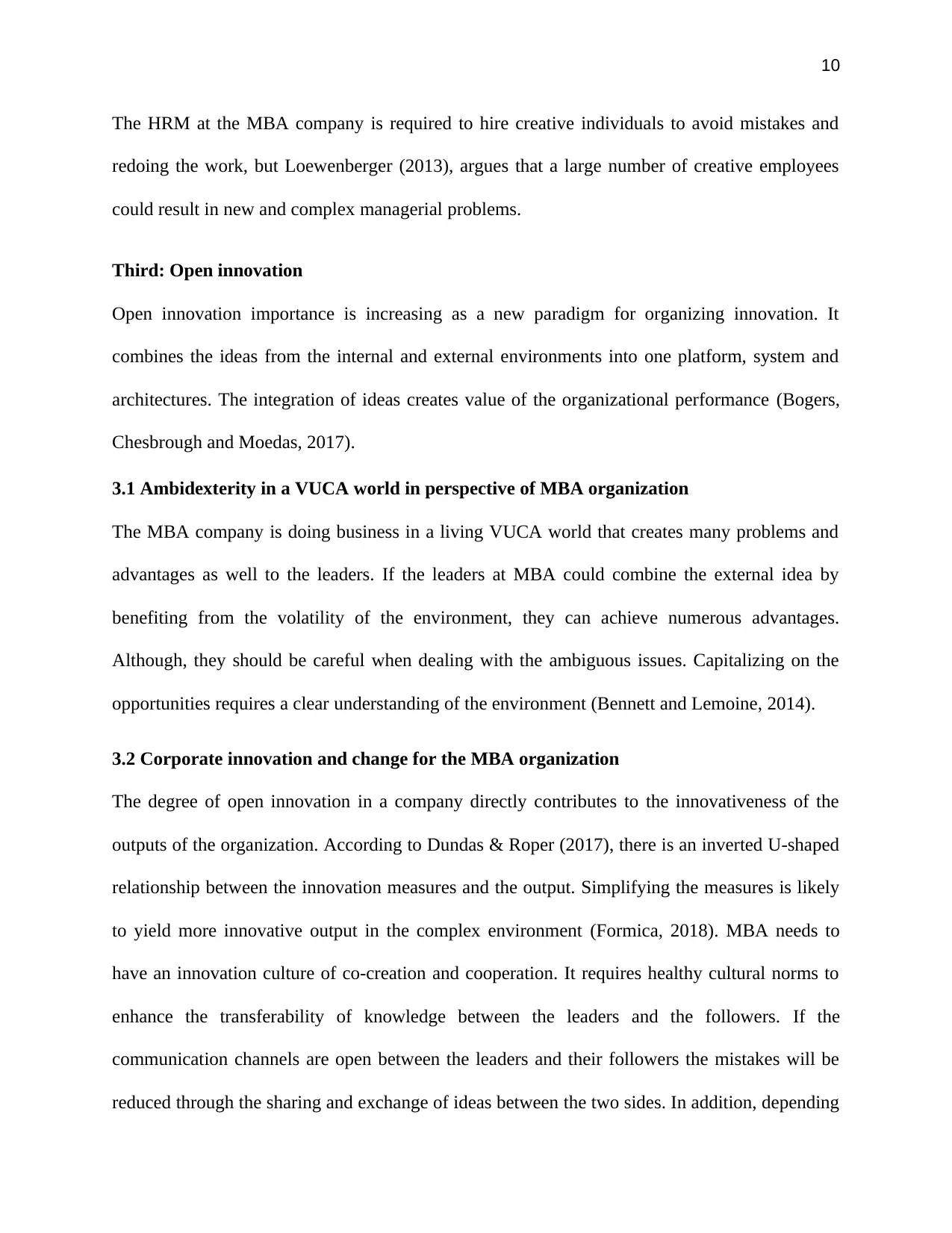
10
The HRM at the MBA company is required to hire creative individuals to avoid mistakes and
redoing the work, but Loewenberger (2013), argues that a large number of creative employees
could result in new and complex managerial problems.
Third: Open innovation
Open innovation importance is increasing as a new paradigm for organizing innovation. It
combines the ideas from the internal and external environments into one platform, system and
architectures. The integration of ideas creates value of the organizational performance (Bogers,
Chesbrough and Moedas, 2017).
3.1 Ambidexterity in a VUCA world in perspective of MBA organization
The MBA company is doing business in a living VUCA world that creates many problems and
advantages as well to the leaders. If the leaders at MBA could combine the external idea by
benefiting from the volatility of the environment, they can achieve numerous advantages.
Although, they should be careful when dealing with the ambiguous issues. Capitalizing on the
opportunities requires a clear understanding of the environment (Bennett and Lemoine, 2014).
3.2 Corporate innovation and change for the MBA organization
The degree of open innovation in a company directly contributes to the innovativeness of the
outputs of the organization. According to Dundas & Roper (2017), there is an inverted U-shaped
relationship between the innovation measures and the output. Simplifying the measures is likely
to yield more innovative output in the complex environment (Formica, 2018). MBA needs to
have an innovation culture of co-creation and cooperation. It requires healthy cultural norms to
enhance the transferability of knowledge between the leaders and the followers. If the
communication channels are open between the leaders and their followers the mistakes will be
reduced through the sharing and exchange of ideas between the two sides. In addition, depending
The HRM at the MBA company is required to hire creative individuals to avoid mistakes and
redoing the work, but Loewenberger (2013), argues that a large number of creative employees
could result in new and complex managerial problems.
Third: Open innovation
Open innovation importance is increasing as a new paradigm for organizing innovation. It
combines the ideas from the internal and external environments into one platform, system and
architectures. The integration of ideas creates value of the organizational performance (Bogers,
Chesbrough and Moedas, 2017).
3.1 Ambidexterity in a VUCA world in perspective of MBA organization
The MBA company is doing business in a living VUCA world that creates many problems and
advantages as well to the leaders. If the leaders at MBA could combine the external idea by
benefiting from the volatility of the environment, they can achieve numerous advantages.
Although, they should be careful when dealing with the ambiguous issues. Capitalizing on the
opportunities requires a clear understanding of the environment (Bennett and Lemoine, 2014).
3.2 Corporate innovation and change for the MBA organization
The degree of open innovation in a company directly contributes to the innovativeness of the
outputs of the organization. According to Dundas & Roper (2017), there is an inverted U-shaped
relationship between the innovation measures and the output. Simplifying the measures is likely
to yield more innovative output in the complex environment (Formica, 2018). MBA needs to
have an innovation culture of co-creation and cooperation. It requires healthy cultural norms to
enhance the transferability of knowledge between the leaders and the followers. If the
communication channels are open between the leaders and their followers the mistakes will be
reduced through the sharing and exchange of ideas between the two sides. In addition, depending
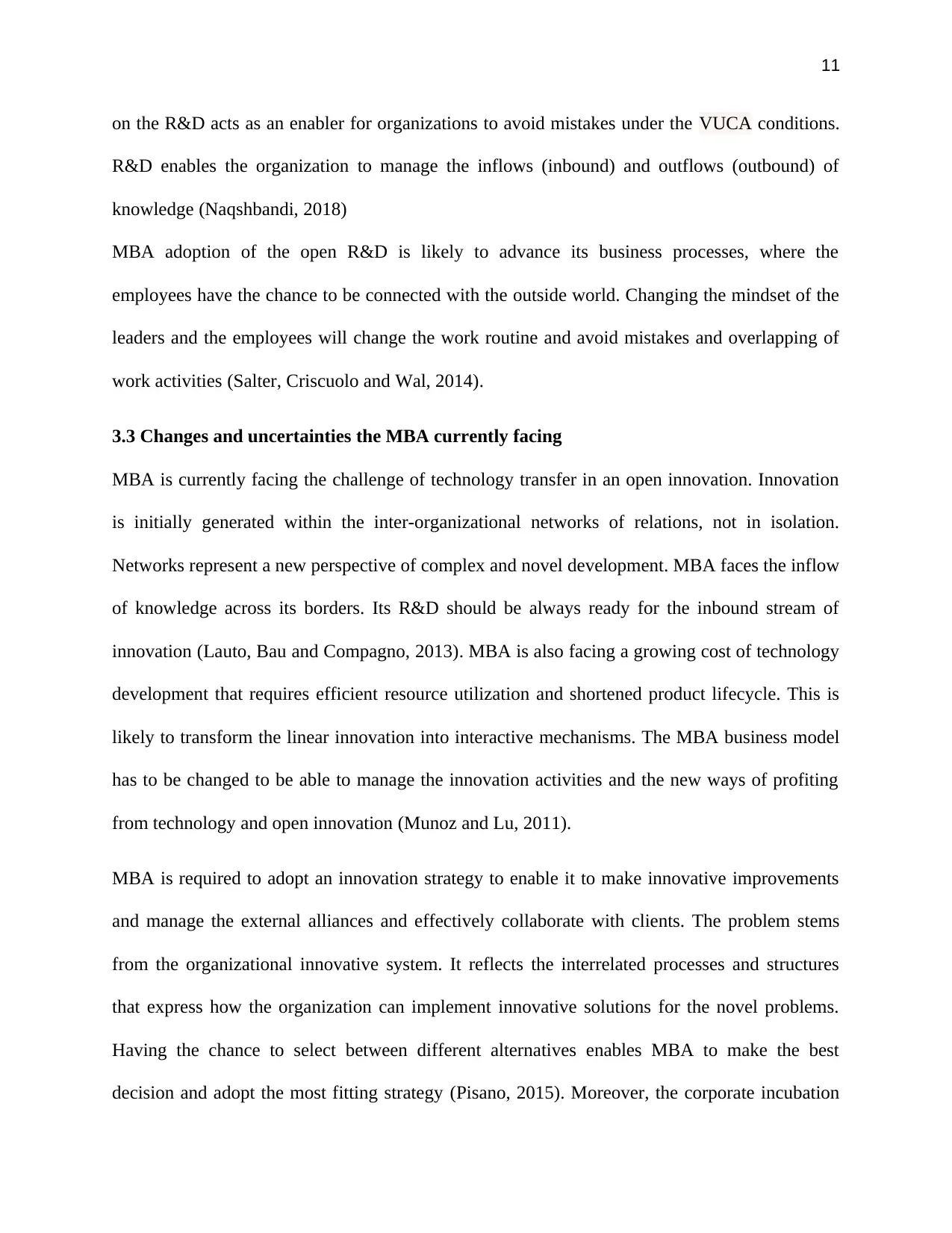
11
on the R&D acts as an enabler for organizations to avoid mistakes under the VUCA conditions.
R&D enables the organization to manage the inflows (inbound) and outflows (outbound) of
knowledge (Naqshbandi, 2018)
MBA adoption of the open R&D is likely to advance its business processes, where the
employees have the chance to be connected with the outside world. Changing the mindset of the
leaders and the employees will change the work routine and avoid mistakes and overlapping of
work activities (Salter, Criscuolo and Wal, 2014).
3.3 Changes and uncertainties the MBA currently facing
MBA is currently facing the challenge of technology transfer in an open innovation. Innovation
is initially generated within the inter-organizational networks of relations, not in isolation.
Networks represent a new perspective of complex and novel development. MBA faces the inflow
of knowledge across its borders. Its R&D should be always ready for the inbound stream of
innovation (Lauto, Bau and Compagno, 2013). MBA is also facing a growing cost of technology
development that requires efficient resource utilization and shortened product lifecycle. This is
likely to transform the linear innovation into interactive mechanisms. The MBA business model
has to be changed to be able to manage the innovation activities and the new ways of profiting
from technology and open innovation (Munoz and Lu, 2011).
MBA is required to adopt an innovation strategy to enable it to make innovative improvements
and manage the external alliances and effectively collaborate with clients. The problem stems
from the organizational innovative system. It reflects the interrelated processes and structures
that express how the organization can implement innovative solutions for the novel problems.
Having the chance to select between different alternatives enables MBA to make the best
decision and adopt the most fitting strategy (Pisano, 2015). Moreover, the corporate incubation
on the R&D acts as an enabler for organizations to avoid mistakes under the VUCA conditions.
R&D enables the organization to manage the inflows (inbound) and outflows (outbound) of
knowledge (Naqshbandi, 2018)
MBA adoption of the open R&D is likely to advance its business processes, where the
employees have the chance to be connected with the outside world. Changing the mindset of the
leaders and the employees will change the work routine and avoid mistakes and overlapping of
work activities (Salter, Criscuolo and Wal, 2014).
3.3 Changes and uncertainties the MBA currently facing
MBA is currently facing the challenge of technology transfer in an open innovation. Innovation
is initially generated within the inter-organizational networks of relations, not in isolation.
Networks represent a new perspective of complex and novel development. MBA faces the inflow
of knowledge across its borders. Its R&D should be always ready for the inbound stream of
innovation (Lauto, Bau and Compagno, 2013). MBA is also facing a growing cost of technology
development that requires efficient resource utilization and shortened product lifecycle. This is
likely to transform the linear innovation into interactive mechanisms. The MBA business model
has to be changed to be able to manage the innovation activities and the new ways of profiting
from technology and open innovation (Munoz and Lu, 2011).
MBA is required to adopt an innovation strategy to enable it to make innovative improvements
and manage the external alliances and effectively collaborate with clients. The problem stems
from the organizational innovative system. It reflects the interrelated processes and structures
that express how the organization can implement innovative solutions for the novel problems.
Having the chance to select between different alternatives enables MBA to make the best
decision and adopt the most fitting strategy (Pisano, 2015). Moreover, the corporate incubation
⊘ This is a preview!⊘
Do you want full access?
Subscribe today to unlock all pages.

Trusted by 1+ million students worldwide
1 out of 21
Related Documents
Your All-in-One AI-Powered Toolkit for Academic Success.
+13062052269
info@desklib.com
Available 24*7 on WhatsApp / Email
![[object Object]](/_next/static/media/star-bottom.7253800d.svg)
Unlock your academic potential
Copyright © 2020–2025 A2Z Services. All Rights Reserved. Developed and managed by ZUCOL.





